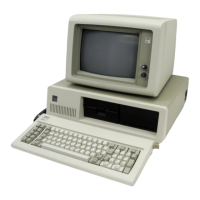instruction forces the microprocessor to wait until the coprocessor
is finished executing (WAIT
FOR
NOT
BUSY).
When
an
incorrect instruction
is
sent to the coprocessor (for
example, divide by 0
or
load a full register), the coprocessor can
signal
the, microprocessor with an interrupt. There are three
conditions
that
will disable the coprocessor interrupt to the
microprocessor:
1.
Exception and interrupt-enable bits of the control word are
set
to
l's
2. System-board switch-block 1, switch 2, set in the
On
position
3. Non-maskable interrupt register (NMI
REG)
is
set to zero.
At
power-on time, the NMI
REG
is
cleared to disable the NMI.
Any program using the coprocessor's interrupt capability must
ensure
that
conditions 2 and 3 are never met during the operation
of
the software or an "Endless WAIT" will occur.
An
"Endless
WAIT"
will have the microprocessor waiting for the
'not
busy'
signal from the coprocessor while the coprocessor
is
waiting for
the microprocessor to interrupt.
Because a memory parity error may also cause an interrupt to the
microproc.essor NMI line, the program should check the
coprocessor status for an exception condition. If a coprocessor
.exception condition
is
not found, control should be passed to the
normal NMI handler. If an 8087 exception condition
is
found,
the
program may clear the exception by executing the FNSAVE
or
the
FNCLEX
instruction, and the exception can be identified
,and acted upon.
The
NMIREG
and the coprocessor's interrupt are tied
to
the
NMI
line through the NMI interrupt logic. Minor modifications
to
programs designed for use with a coprocessor must be made
before'the programs will be compatible with the IBM Personal
Computer
Math
Coprocessor.
Coprocessor 2-5

